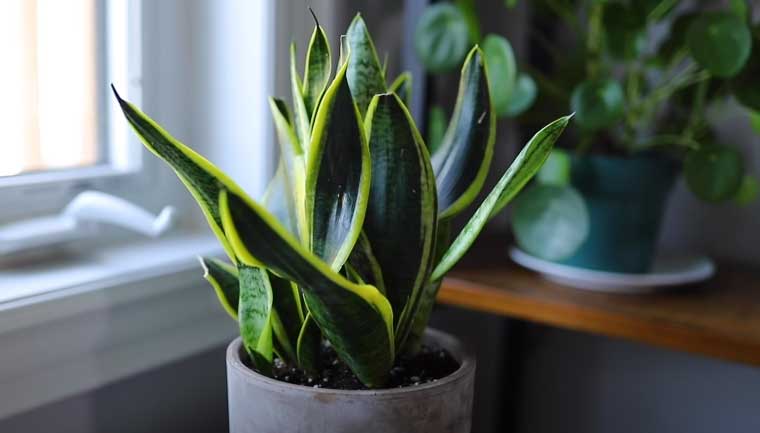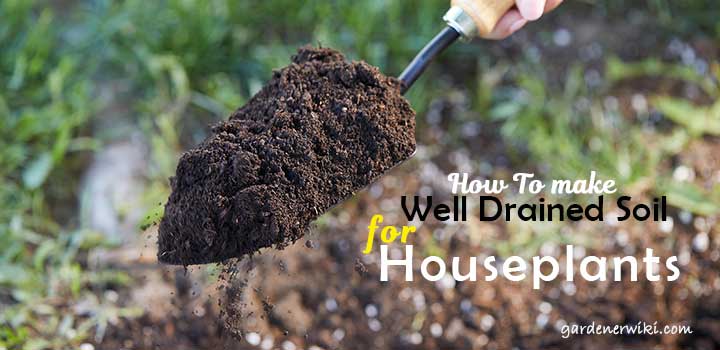Houseplants are a great addition to any space, be it a home, office, or restaurant. It brings a touch of green that brightens up a room and freshens up the air. But for these plants to thrive, they need sunlight, oxygen, water, and, most importantly, well-drained soil.
Well-drained soil is vital to keep the roots of a plant healthy. Solid, compact soil prevents air from flowing to the roots and makes the environment inside warm and uninhabitable for the plants.
Eventually, if not given well-drained soil, you will find that your plants are withering and dying. To prevent any such circumstances, you need to understand how to make well-drained soil for houseplants. And that’s what I’m going to share today with you.
Why Is Well-Drained Soil Important for a Plant’s Survival?

Roots are the heart of a plant. Therefore, any disturbance caused to the roots reduces the lifespan of the potted plants. Water, good soil, sunlight, and oxygen are vital to keeping the stars of your eyes alive.
Apart from the elements mentioned earlier, water-drained soil is essential in maintaining a plant. Well-drained water enables water and oxygen to reach the roots of the plant. Without the correct amount of water and oxygen, the roots will wilt and eventually die.
Therefore, good water drainage in the soil is essential; otherwise, the soil will be deprived of the necessities. Just as the name suggests, well-drained soil is a kind of soil that allows good water drainage.
Meaning the soil enables just the right amount of time for the plant to absorb water and prevent quick draining and water puddling in the pot.
If the water in the soil for indoor plants drains quickly, it gives the plant very little time to absorb moisture. Therefore, the plants are unlikely to survive long due to a water shortage.
On the other hand, if water is trapped in the soil for too long, the roots will rot, losing their beautiful white, healthy color. Moreover, well-drained soil is the home ground for earthworms and other microorganisms to grow, improving the soil quality by making it more fertile.
How to Create Well-Drained Soil for Houseplants?
Soil found in the garden is not ideal for your indoor plants. The compact, heavy clay-like garden soil will not let the roots breathe and would be constricting.

Moreover, the hard mix of the soil will prevent the roots from spreading their wings. These restrictions will prevent your plant from flourishing. An easy solution is to plant trees in potting mix and use a potting soil.
What Is Potting Soil and Potting Mix?
Potting soil and potting mix are lightweight soil that does not necessarily contain any dirt but is instead a mix of different elements that retain moisture, provides good drainage, and have the appearance of the soil.
In addition, the potting mix is made of organic materials, so it won’t be infected with pests that harm the plants. However, a specific and minor difference exists between potting mix and soil.
The potting mix does not have any percentage of soil and is made up of other elements, but potting soil has a low rate of soil which makes it denser.
What Are the Elements Used for Potting Soil and Mix?
Potting soil and potting mix contain a mixture of perlite, sand, fertilizer, vermiculite, wood chips, and rocks. These coarse materials permit water and oxygen to flow and let the roots spread.
- Perlite
Perlite is a small, white rock that can soak up nutrients and water. Meanwhile, it is very lightweight, which stops the soil from weighing down.
Furthermore, the round balls occupy quite some space, thus making the soil breathable. Additionally, the stones can retain moisture, keeping the soil’s temperature in check and preventing cracking.
- Sand
Sand particles are tiny and coarse, making them the most economical option for good drainage. In addition, the tiny particles maneuver between the soil, preventing it from clumping and, in return, allowing unrestricted water movement.
- Fertilizer
Fertilizers not only provide nutrients to the soil but can retain moisture too. As a result, they can absorb any excess water from the soil and halt excess water pooling.
- Vermiculite
It is another type of small stone-like material too. It can soak up water and make the soil flaky. When it is integrated with other materials like perlite and compost, it is a recipe for success, as this combination can make inhabitable soil usable and good.
- Wood chips
Wood chips are a great organic material to add to the soil. It can decompose over time and release nutrients to the soil, making it fertile and healthy.
- Rocks
Tiny rocks are readily available and can be a great addition to stop soil from becoming hard and allow water to pass through. Although rocks are not as lightweight as vermiculite and perlite, they can weigh down the soil, which is a disadvantage.
Rocks are a good alternative for the short run, but the soil has to have other good drainage elements to ensure that it is in good health.
6 Tips You Should Consider While Making Well-Drained Soil for Houseplants
If you want to make perfect well-drained soil for your houseplants, following some easy techniques can help to make them better. Here are a few tips to make well-drained soil.
- Use fresh organic compost to mix for high drainage capacity.
- Add some clay pebbles that can absorb the excess water from the plant pot.
- Mix sand into the soil to keep it that ensure a better drainage system
- Use lime or calcium carbonate to upgrade the soil’s pH level to make the drainage better.
- Keep the soil mix in the plastic storage box to cure it for 2 weeks.
- Place the soil into unglazed terracotta pots to keep it well-drained.
FAQs
How do I know if my soil is well-drained?
First, you have to spade a 30 cm deep and wide hole and pour it with water. Well-drained soil will take less than 10 minutes to drain. And if your soil is not drained enough, it can take more than 1 hour to absorb the water.
Can I use well-drained soil for my garden plants?
Yes. You can. It depends on the plants you are cultivating in the garden. Especially if you are cultivating Lavender, Agastache, Salvia, Penstemon, or any perennials in your garden, you must use well-drained soil.
Final Words
A well-drained soil for houseplants is one of the most vital components of keeping an indoor plant healthy.
Unfortunately, indoor plants are deprived of many natural elements and processes that help a plant survive difficult circumstances.
As a result, I’ve to intervene and ensure that our houseplants get the best conditions to have healthy indoor plants.
If you have diligently followed so far, I can say that now you’re an expert on how to make well-drained soil for houseplants. And I can deduce that some care and a small investment will help your plants flourish.
So, now that you know everything about well-drained soil, you can ensure that your favorite plant will have a long and prosperous life!